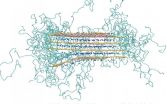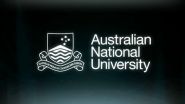(Press-News.org) UCL scientists have shown how advanced computer simulations can be used to design new composite materials. Nanocomposites, which are widely used in industry, are revolutionary materials in which microscopic particles are dispersed through plastics. But their development until now has been largely by trial and error.
The 'virtual lab' developed using supercomputer simulations greatly improves scientists' understanding of how composite materials are built on a molecular level. They allow the properties of a new material to be predicted based simply on its structure and the way it is manufactured, which the team behind the project say is a holy grail of materials science.
"Developing composite materials has been a bit of a trial-and-error process until now," says Dr James Suter (UCL Chemistry), the first author of the study. "It typically involves grinding and mixing the ingredients and hoping for the best. Of course we test the properties of the resulting materials, but our understanding of how they are structured and why they have the properties they have, is quite limited. Our work means we can now predict how a new nanocomposite will perform, based only on their chemical composition and processing conditions."
The team led by Professor Peter Coveney and based at the UCL Centre for Computational Science, looked at a specific type of composite material, where particles of the clay called montmorillonite are mixed with a synthetic polymer. It is impossible to study these with microscopes - the processes are smaller than the wavelength of light, and therefore can't be observed directly. Moreover, the structure of the clay particles makes them tricky to study through less direct methods. The clay particles resemble stacked packs of playing cards, made up of tightly packed sheets (the cards) that may separate out and sometimes cleave off entirely as the long chain-like polymer molecules slide between them. This means much of the interaction between the polymer and the clay is hidden from view.
"Our study developed computer simulations that describe precisely how the layered particles and the polymer chains interact," says co-author Dr Derek Groen (UCL Chemistry). "The challenge is getting enough precision without the computer simulation being unmanageable. Certain processes need a highly detailed simulation which describes everything on a quantum level - but if we simulated the entire sample at that level, we'd literally need several decades of supercomputer time."
The team showed that certain interactions, such as when the edge of a sheet of clay comes into contact with a polymer chain, require a quantum simulation; some require only an atomic-level simulation (where each atom in a molecule is represented as a ball on a spring); while others can have an even lower level of fidelity, bundling atoms together to give the approximate shape and properties of a molecule. These multiple ways of representing the same system constitute a multiscale approach to modelling materials, where the most appropriate level of detail can be adopted for different parts of the simulation.
"When you make approximations like this, it's important to test that they are accurate," says Dr Suter. "A lot of our work involved comparing the different types of simulation and ensuring that they gave results that were consistent with each other. The quantum mechanical model starts from first principles and is derived from the most basic laws of physics, so we know it's right. But there are quite a few assumptions involved in a molecular model, and we had to ensure those assumptions were correct."
The resulting simulations show for the first time exactly how the polymers and clay particles interact. The long, chain-like polymer molecules (which typically come in a tangled bundle) unwind themselves, slip between the sheets of the clay particles, and with certain types of polymer, gently coax them apart. On longer length and timescales, which the multiscale simulations permitted the team to study, they were able to see the aggregation of the polymer-entangled clay sheets into organised arrays of stacks, with very different properties. These predictions are already being used to see how to improve construction of composite materials.
The simulations required extensive and closely coordinated use of multiple high-performance computing facilities, including ARCHER (a UK supercomputer in Edinburgh) and STFC's BlueJooule and BlueWonder (supercomputing facilities at the Daresbury Laboratory). The massive computing power and choreography required to carry out this type of simulation means it would have been impossible a decade ago, and very difficult even five years ago.
INFORMATION:
A new study shows that college students in online courses give better evaluations to instructors they think are men - even when the instructor is actually a woman.
"The ratings that students give instructors are really important, because they're used to guide higher education decisions related to hiring, promotions and tenure," says Lillian MacNell, lead author of a paper on the work and a Ph.D. student in sociology at NC State. "And if the results of these evaluations are inherently biased against women, we need to find ways to address that problem."
To address whether ...
Reston, Va. (December 9, 2014) - Cancer therapy can be much more effective using a new way to customize nuclear medicine treatment, researchers say in the December 2014 issue of The Journal of Nuclear Medicine. The process could also be useful for other diseases that could benefit from targeted radiation.
Targeted therapy with radiopharmaceuticals--radioactive compounds used in nuclear medicine for diagnosis or treatment--has great potential for the treatment of cancer, especially for cancer cells that have migrated from primary tumors to lymph nodes and secondary organs ...
PROVIDENCE, R.I. [Brown University] -- Maybe distraction is not always the enemy of learning. It turns out in surprising Brown University psychology research that inconsistent distraction is the real problem. As long as our attention is as divided when we have to recall a motor skill as it was when we learned it, we'll do just fine, according to the new study.
Most learned motor tasks -- driving, playing sports or music, even walking again after injury -- occur with other things going on. Given the messiness of our existence, said lead researcher Joo-Hyun Song, assistant ...
This news release is available in German.
Not all boreholes are the same. Scientists of the Karlsruhe Institute of Technology (KIT) used mobile measurement equipment to analyze gaseous compounds emitted by the extraction of oil and natural gas in the USA. For the first time, organic pollutants emitted during a fracking process were measured at a high temporal resolution. The highest values measured exceeded typical mean values in urban air by a factor of one thousand, as was reported in ACP journal.
(DOI 10.5194/acp-14-10977-2014)
Emission of trace gases by ...
TORONTO - Dec. 9, 2014 (Toronto) - Scientists at the Centre for Addiction and Mental Health (CAMH) have identified a novel drug target that could lead to the development of better antipsychotic medications.
Dr. Fang Liu, Senior Scientist in CAMH's Campbell Family Mental Health Research Institute and Professor in the Department of Psychiatry, University of Toronto, and her team published their results online in the journal Neuron.
Current treatment for patients with schizophrenia involves taking medications that block or interfere with the action of the neurotransmitter ...
Hummingbirds rely on their ability to hover in order to feed off the nectar of flowers.
It's an incredible feat of flying requiring mind boggling visual processing power, but two University of British Columbia researchers found a glitch in the system, something the tiny birds are powerless to control.
The researchers put hovering hummingbirds through a virtual reality experiment that showed the birds can't control their inflight response to some visual stimuli.
In a laboratory flight arena, hummingbirds hovered around a plastic feeder while images were projected on ...
As solar panels become less expensive and capable of generating more power, solar energy is becoming a more commercially viable alternative source of electricity. However, the photovoltaic cells now used to turn sunlight into electricity can only absorb and use a small fraction of that light, and that means a significant amount of solar energy goes untapped.
A new technology created by researchers from Caltech, and described in a paper published online in the October 30 issue of Science Express, represents a first step toward harnessing that lost energy.
Sunlight is ...
An international team of scientists has discovered the earliest known engravings from human ancestors on a 400,000 year-old fossilised shell from Java.
The discovery is the earliest known example of ancient humans deliberately creating pattern.
"It rewrites human history," said Dr Stephen Munro from School of Archaeology and Anthropology at The Australian National University (ANU).
"This is the first time we have found evidence for Homo erectus behaving this way," he said.
The newly discovered engravings resemble the previously oldest-known engravings, which are ...
Animals that regulate their body temperature through the external environment may be resilient to some climate change but not keep pace with rapid change leading to potentially disastrous outcomes for biodiversity.
A study by the University of Sydney and University of Queensland showed many animals can modify the function of their cells and organs to compensate for changes in the climate and have done so in the past, but the researchers warn that the current rate of climate change will outpace animals' capacity for compensation (or acclimation).
The research has just ...
SAN ANTONIO -- Use of anthracycline-based chemotherapy, a common treatment for breast cancer, has negligible cardiac toxicity in women whose tumors have BRCA1/2 mutations -- despite preclinical evidence that such treatment can damage the heart.
The findings, to be presented at the 2014 San Antonio Breast Cancer Symposium (SABCS), represent a unique effort between cardiologists and oncologists at Georgetown Lombardi Comprehensive Cancer Center and MedStar Heart & Vascular Institute in Washington to answer a vital clinical question.
"Our study was prompted by evidence from ...




